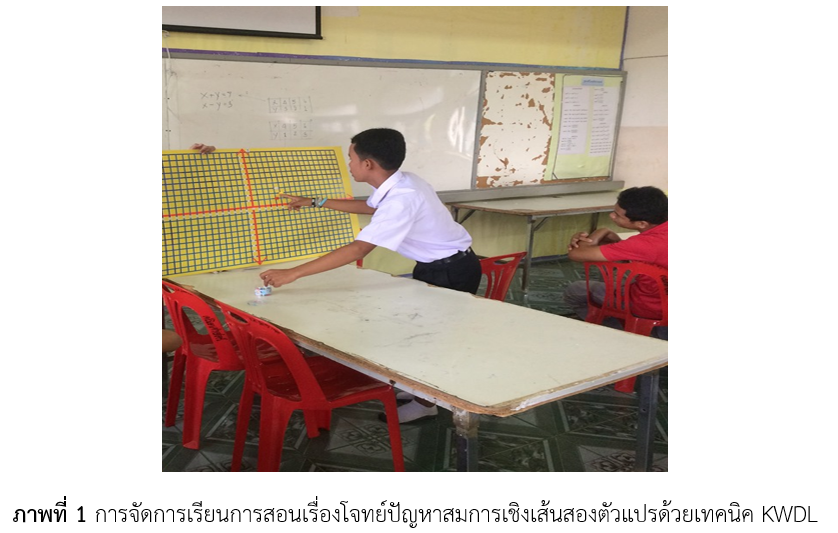การพัฒนาทักษะการแก้โจทย์ปัญหาคณิตศาสตร์ เรื่อง สมการเชิงเส้นสองตัวแปร โดยใช้เทคนิค KWDL ของนักเรียนชั้นมัธยมศึกษาปีที่ 3
Main Article Content
บทคัดย่อ
การวิจัยในครั้งนี้ มีวัตถุประสงค์เพื่อพัฒนาทักษะการแก้โจทย์ปัญหาคณิตศาสตร์ เรื่อง สมการเชิงเส้นสองตัวแปร โดยใช้เทคนิค KWDL ของนักเรียนชั้นมัธยมศึกษาปีที่ 3 ให้มีคะแนนเฉลี่ยไม่น้อยกว่าร้อยละ 70 ของคะแนนเต็ม และมีจำนวนนักเรียนที่ผ่านเกณฑ์ไม่น้อยกว่าร้อยละ 70 ของจำนวนนักเรียนทั้งหมด กลุ่มตัวอย่างที่ใช้ในการวิจัย ได้แก่ นักเรียนชั้นมัธยมศึกษาปีที่ 3 โรงเรียนเนินยางประชาสามัคคี ที่กำลังศึกษาอยู่ในภาคเรียนที่ 1 ปีการศึกษา 2562 จำนวน 35 คน ได้มาจากการสุ่มแบบแบ่งกลุ่ม (cluster random sampling) โดยใช้รูปแบบการวิจัยเชิงปฏิบัติการ 2 วงจร เครื่องมือที่ใช้คือ 1) เครื่องมือที่ใช้ในการทดลองปฏิบัติ ได้แก่ แผนการจัดการเรียนรู้ 6 แผน 2) เครื่องมือที่ใช้ในการสะท้อนผล ได้แก่ แบบบันทึกผลการจัดกิจกรรมการเรียนรู้ด้วยเทคนิค KWDL 3) เครื่องมือที่ใช้ในการประเมินประสิทธิผล ได้แก่ ข้อสอบแบบอัตนัย จำนวน 5 ข้อสำหรับวัดทักษะการแก้โจทย์ปัญหาคณิตศาสตร์ สถิติที่ใช้ในการวิเคราะห์ข้อมูล ได้แก่ ค่าเฉลี่ย ส่วนเบี่ยงเบนมาตรฐาน และค่าร้อยละ ผลการวิจัยพบว่า ผลลัพธ์ของทักษะการแก้โจทย์ปัญหาของนักเรียนคิดเป็นร้อยละ เท่ากับร้อยละ 81.26 ของคะแนนเต็ม และมีนักเรียน จำนวน 35 คน ที่ผ่านเกณฑ์ เท่ากับร้อยละ 100.00 ของจำนวนนักเรียนทั้งหมดซึ่งสูงกว่าเกณฑ์ที่กำหนด
Article Details

อนุญาตภายใต้เงื่อนไข Creative Commons Attribution-NonCommercial-NoDerivatives 4.0 International License.
วารสารวิทยาศาสตร์และวิทยาศาสตร์ศึกษา (JSSE) เป็นผู้ถือลิสิทธิ์บทความทุกบทความที่เผยแพร่ใน JSSE นี้ ทั้งนี้ ผู้เขียนจะต้องส่งแบบโอนลิขสิทธิ์บทความฉบับที่มีรายมือชื่อของผู้เขียนหลักหรือผู้ที่ได้รับมอบอำนาจแทนผู้เขียนทุกนให้กับ JSSE ก่อนที่บทความจะมีการเผยแพร่ผ่านเว็บไซต์ของวารสาร
แบบโอนลิขสิทธิ์บทความ (Copyright Transfer Form)
ทางวารสาร JSSE ได้กำหนดให้มีการกรอกแบบโอนลิขสิทธิ์บทความให้ครบถ้วนและส่งมายังกองบรรณาธิการในข้อมูลเสริม (supplementary data) พร้อมกับนิพนธ์ต้นฉบับ (manuscript) ที่ส่งมาขอรับการตีพิมพ์ ทั้งนี้ ผู้เขียนหลัก (corresponding authors) หรือผู้รับมอบอำนาจ (ในฐานะตัวแทนของผู้เขียนทุกคน) สามารถดำเนินการโอนลิขสิทธิ์บทความแทนผู้เขียนทั้งหมดได้ ซึ่งสามารถอัพโหลดไฟล์บทความต้นฉบับ (Manuscript) และไฟล์แบบโอนลิขสิทธิ์บทความ (Copyright Transfer Form) ในเมนู “Upload Submission” ดังนี้
1. อัพโหลดไฟล์บทความต้นฉบับ (Manuscript) ในเมนูย่อย Article Component > Article Text
2. อัพโหลดไฟล์แบบโอนลิขสิทธิ์บทความ (Copyright Transfer Form) ในเมนูย่อย Article Component > Other
ดาวน์โหลด ไฟล์แบบโอนลิขสิทธิ์บทความ (Copyright Transfer Form)
เอกสารอ้างอิง
Chaochalat, P., Niyomsap, N. and Sirithanyarat, C. (2018). Development of learning achievement and mathematical problem-solving ability of Mathayomsuksa 1 students using problem-based learning with KWDL teaching technique (in Thai). Journal for Social Sciences Research, 9(1), 180-199.
Dabthong, B. (2018). The Development of Learning Management Model for Mathematical Problem Sloving by Using Inquiry cycle (5E) and K-W-D-L Technique for Students in Prathomsuksa 4 (in Thai). Journal of Education Prince of Songkla University, 29(2), 164-174.
Kemmis, S. and McTaggart, R. (eds). (1988). The Action Research Planner (3rd Ed.). Waurn Ponds: Deakin University Press.
Lohitya, U., Mounnamprang, P., Borvonphongsakul, S. (2012). The result of learning of syndicate and KWDL-technique in development of achievement the problem solving for Prathomsuksa III (in Thai). Journal of Graduate Studies Valaya Alongkorn Rajabhat University, 6(1), 11-18.
Luenklang, P., Hembasat, P. and Pimpasalee, W. (2019). The development of problem-solving skill in ratios and percentages for Grade-8 students by incorporating cooperative learning STAD technique into KWDL technique (in Thai). Journal of Science and Science Education, 2(2), 145-153.
Ministry of Education, Thailand. (2010). Basic education core curriculum B.E. 2551 (A.D. 2008) (in Thai). Bangkok: The Agricultural Co-operative Federation of Thailand Ltd.
Ogle, D. M. (1986). K-W-L: A teaching model that develops active reading of expository text. Reading Teacher, 39(6), 564-570.
Pengjan, C., Tanachaikhan, N. and Panyapreuk, S. (2017). The learning management by using KWDL technique to develop learning achievement in mathematics entitle “sentence problems” of Prathomsuksa 6 students (in Thai). Journal of Graduate Research, 8(1), 71-82.
Srisa-ard, B. (2013). Preliminary research (ninth Edition). Bangkok: Suweeriyasaan.
The National Institute of Educational Testing Service, Thailand. (2020). Basic statistics of O-NET test results for grade-9 student during academic year 2014 - 2017 (in Thai). Retrieved 1 March 2020, from NIETS: https://www.niets.or.th/uploads/editor/files/Download/ค่าสถิติพื้นฐาน%20ม3.pdf
Trangan, N. and Thongaime, A. (2016). The study of effects of KWDL for problem solving of physics or learning on electricity and magnetism (in Thai). Journal of Graduate School, 5(2), 764-775.


